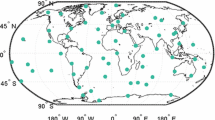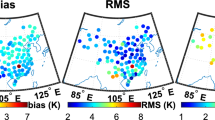Abstract
In global navigation satellite system (GNSS) meteorology, the weighted mean temperature (Tm) is a variable parameter in the conversion between zenith wet delay errors of GNSS and precipitable water vapor. The combined models of Tm, which are modeled with a combination of Tm seasonal variations and relationships between Tm and site meteorological measurements (mainly site measured temperature), have been proven to be of relatively higher accuracy. In this study, an improved combined model for Tm called the NN-II model was developed and is the second generation of the NN model. Similar to the NN model, NN-II is a combined model and is modeled by using the neural network model. The NN model was only designed for Tm estimates near the surface, while NN-II was designed for Tm estimates from the surface to almost the top of the troposphere. Compared with the NN model, the NN-II model shows some advanced features in terms of model design: modeled Tm data cover from the surface to almost the top of the troposphere, a more accurate seasonal Tm from the GTrop-Tm model is used, and the input variables are refined. Due to these refinements, the bias and RMSE of NN-II for global Tm from the surface to almost the top of the troposphere are 0.08 K and 3.34 K, respectively, and this new model shows 29.1% and 40.6% improved accuracies compared to those of the GTrop-Tm model and the NN model, respectively. The accuracy advantage is maintained over different heights of the troposphere on a global scale.

Similar content being viewed by others
Data availability
The radiosonde data used in this study are available at ftp://ftp.ncdc.noaa.gov/pub/data/igra/v1/derived-v2/data-por/. All data and results in this paper can be provided to readers by contacting the corresponding author.
References
Bevis M, Businger S, Herring TA, Rocken C, Anthes RA, Ware RH (1992) GPS meteorology: remote sensing of atmospheric water vapor using the global positioning system. J Geophys Res 97:15787–15801
Böhm J, Möller G, Schindelegger M, Pain G, Weber R (2015) Development of an improved empirical model for slant delays in the troposphere (GPT2w). GPS Solut 19(3):433–441
Chen P, Yao W, Zhu X (2014) Realization of global empirical model for mapping zenith wet delays onto precipitable water using NCEP re-analysis data. Geophys J Int 198(3):1748–1757
Ding M (2018) A neural network model for predicting weighted mean temperature. J Geod 92(10):1187–1198
Ding M (2020) Reducing ZHD–ZWD mutual absorption errors for blind ZTD model users. Acta Geod Geophys 55:51–62
Ding M, Hu W (2017) A further contribution to the seasonal variation of weighted mean temperature. Adv Space Res 60(11):2414–2422
Durre I, Vose RS, Wuertz DB (2006) Overview of the integrated global radiosonde archive. J Clim 19(1):53–68
Haykin S (1998) Neural networks: a comprehensive foundation, 2nd edn. Prentice Hall, Upper Saddle River
Huang L, Jiang W, Liu L, Chen H, Ye S (2019a) A new global grid model for the determination of atmospheric weighted mean temperature in GPS precipitable water vapor. J Geod 93(2):159–176
Huang L, Liu L, Chen H, Jiang W (2019b) An improved atmospheric weighted mean temperature model and its impact on GNSS precipitable water vapor estimates for China. GPS Solut 23(2):51
Ross RJ, Rosenfeld S (1997) Estimating mean weighted temperature of the atmosphere for global positioning system applications. J Geophys Res 102(D18):21719–21730
Sun Z, Zhang B, Yao Y (2019) A global model for estimating tropospheric delay and weighted mean temperature developed with atmospheric reanalysis data from 1979 to 2017. Remote Sens 11(16):1893
Wang J, Zhang L, Dai A (2005) Global estimates of water-vapor-weighted mean temperature of the atmosphere for GPS applications. J Geophys Res 110(D21):D21101
Wang X, Zhang K, Wu S, Fan S, Cheng Y (2016) Water vapor-weighted mean temperature and its impact on the determination of precipitable water vapor and its linear trend. J Geophys Res 121(2):833–852
Yang F, Guo J, Meng X, Shi J, Zhang D, Zhao Y (2020) An improved weighted mean temperature (Tm) model based on GPT2w with Tm lapse rate. GPS Solut 24:46
Yao Y, Zhu S, Yue S (2012) A globally applicable, season-specific model for estimating the weighted mean temperature of the atmosphere. J Geod 86(12):1125–1135
Yao Y, Zhang B, Xu C, Chen J (2014a) Analysis of the global Tm − Ts correlation and establishment of the latitude-related linear model. Chin Sci Bull 59(19):2340–2347
Yao Y, Xu C, Zhang B, Cao N (2014b) GTm-III: a new global empirical model for mapping zenith wet delays onto precipitable water vapour. Geophys J Int 197(1):202–212
Yao Y, Zhang B, Xu C, Yan F (2014c) Improved one/multi-parameter models that consider seasonal and geographic variations for estimating weighted mean temperature in ground-based GPS meteorology. J Geod 88(3):273–282
Yao Y, Sun Z, Xu C, Xu X, Kong J (2018) Extending a model for water vapor sounding by ground-based GNSS in the vertical direction. J Atmos Sol Terr Phys 179:358–366
Acknowledgements
The author would like to thank Dr. Ming Shangguan and Dr. Zhen Li because this study was supported by their funding, i.e., the Natural Science Foundation of Jiangsu Province (BK20170665) and the National Natural Science Foundation of China (41601488).
Author information
Authors and Affiliations
Corresponding author
Additional information
Publisher's Note
Springer Nature remains neutral with regard to jurisdictional claims in published maps and institutional affiliations.
Electronic supplementary material
Below is the link to the electronic supplementary material.
Rights and permissions
About this article
Cite this article
Ding, M. A second generation of the neural network model for predicting weighted mean temperature. GPS Solut 24, 61 (2020). https://doi.org/10.1007/s10291-020-0975-3
Received:
Accepted:
Published:
DOI: https://doi.org/10.1007/s10291-020-0975-3




